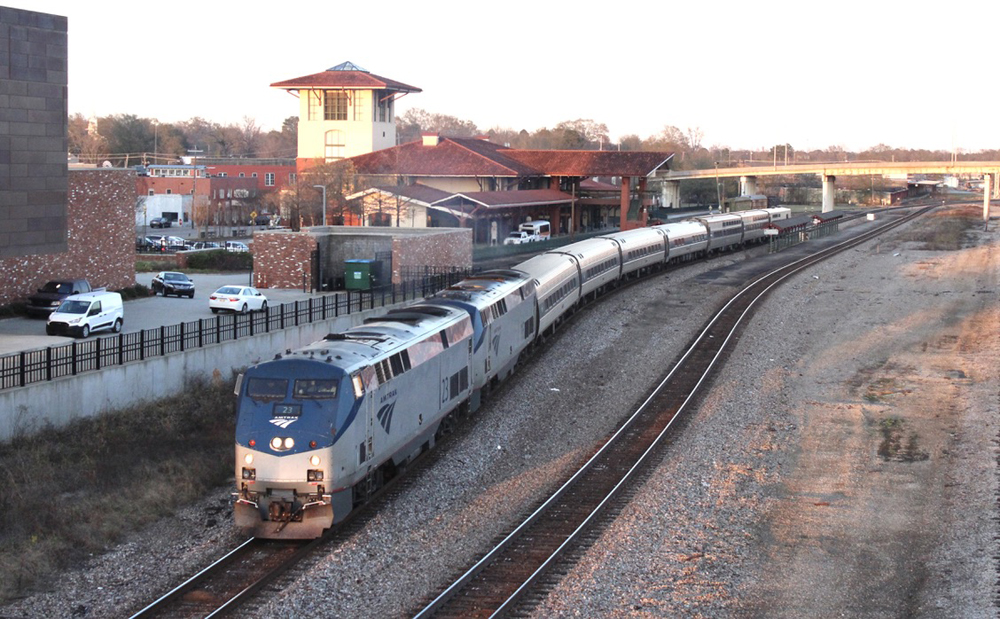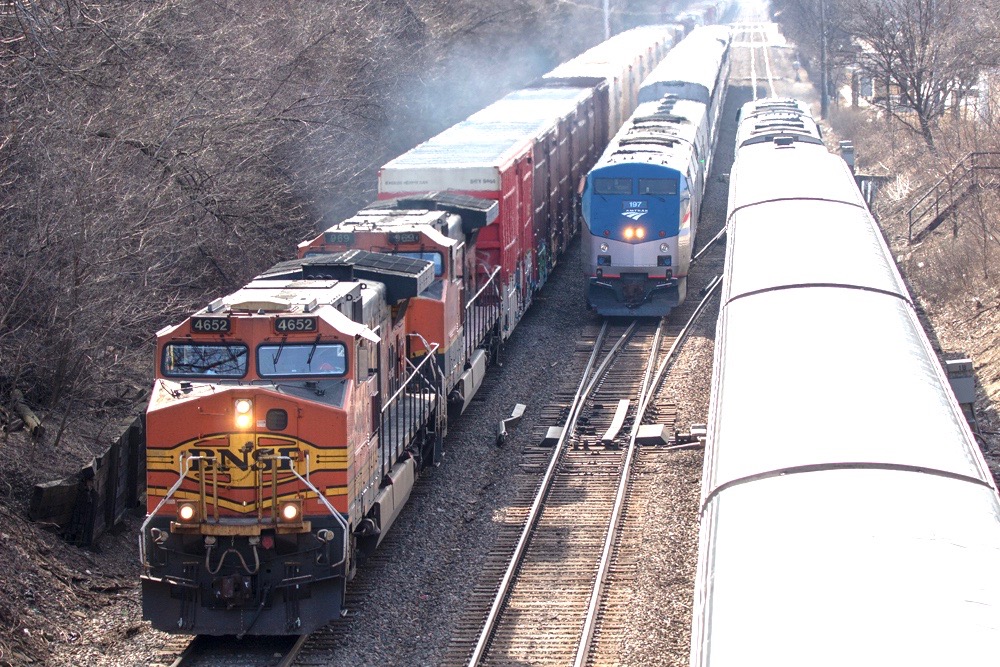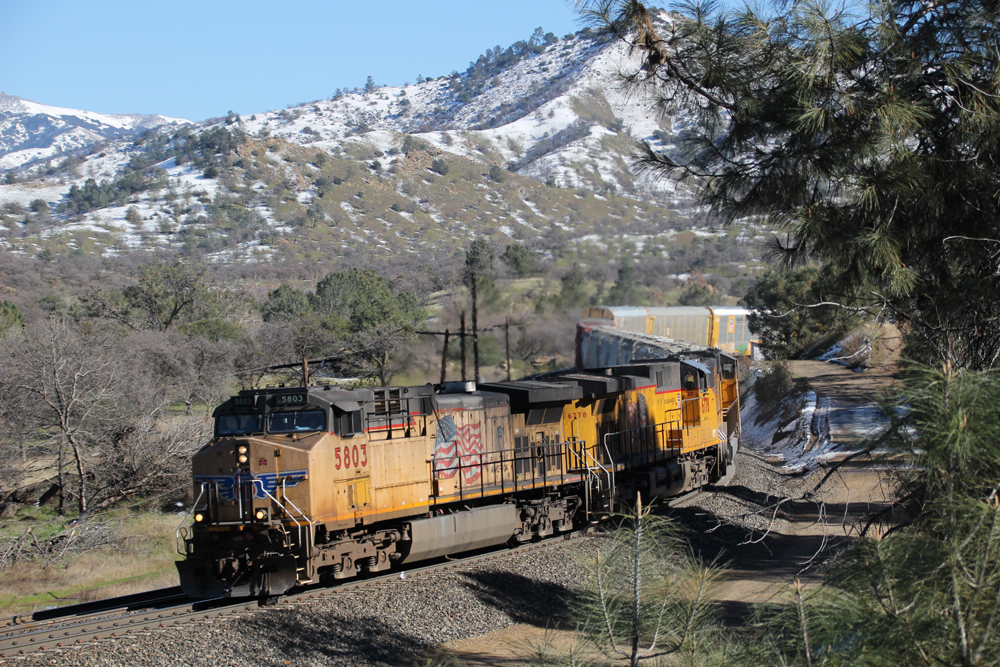
Rail shipper groups say the poor on-time performance of all 15 Amtrak long-distance trains — which prompted the Justice Department to file a lawsuit last week against Norfolk Southern for its handling of the Crescent — is merely a reflection of Class I railroad freight operations.
“This is a symptom of freight rail network capacity and fluidity problems. While some may view it as a zero-sum game, the root cause is that the railroads, not just NS, have elected to avoid investing in adequate staffing and adequate track capacity,” says Ann Warner, who represents several shipper groups including the Freight Rail Customer Alliance and National Industrial Transportation League.
Class I railroad freight service, shippers argue, suffers from Wall Street’s insistence on low operating ratios and keeping capital expenses to a minimum in order to fund share buyback programs.
“The result is that they run trains that are too long for their existing sidings, causing congestion, degraded velocity, poor service, and a lack of resiliency,” Warner says. “These are the same problems that plague shippers generally — Amtrak is just the canary in the coal mine.”

Wick Moorman, who served as Amtrak’s chief executive for a year after retiring as CEO of Norfolk Southern in 2015, says the canary analogy is correct. While at the helm of NS, Moorman would take a close look at Amtrak performance on each corridor. “If Amtrak wasn’t running well, you needed to take a look at what else was going on,” he says.
The Justice Department suit, which contends NS has not given the Crescent the right of preference over freight trains, is only the second filed since Amtrak was created in 1971. A similar case, which Amtrak brought against Union Pacific in December 2022 over freight train interference with the Sunset Limited, is making its way through the Surface Transportation Board. It’s the first on-time performance dispute brought to the STB since the agency gained the authority to investigate violations of the federal Amtrak service standards that went into effect in 2020.

Moorman says the preference statute is open to interpretation. The frustration at Amtrak, he says, is what does preference mean? “The first thing you have to do is define preference and link it to some acceptable level of on-time performance,” Moorman says. The second step is creating an enforcement mechanism that will ensure that level of on-time arrivals, he says.
Some rail shippers are nervous that a strict interpretation of the right of preference will degrade freight service. Rick Paterson, a railroader turned financial analyst at Loop Capital Markets, closely follows the performance metrics that the freight railroads are required to report to the STB each week. He says shippers’ concerns are justified in busy freight corridors shared with Amtrak trains.
“There’s certainly a recipe for chaos here if every Amtrak train suddenly becomes a true hotshot and everything ahead has to get out of the way,” Paterson says. “We’ve seen situations in the past when the railroads tried to run fast small parcel intermodal hotshots for UPS, but the operational disruption was untenable.”
Several veteran railroad operating officials also pointed to the UPS bullet train experiments from two decades ago as an example of what can happen to overall service levels when priority trains see nothing but green signals and are able to run at track speed over their entire routes.
BNSF Railway parted the waters for the once-weekly UPS hotshot that left Los Angeles on a Monday and was due in New Jersey by Friday. BNSF determined that the delays the bullet train inflicted on the rest of its traffic were unacceptable. Norfolk Southern reached the same conclusion after its participation in the test runs east of Chicago. Union Pacific picked up the baton, however, and ran the service for a few months in conjunction with CSX. But UP threw in the towel, too, due to the collateral damage the hotshot caused to the rest of UP’s traffic, including its high-priority Z trains.
“Passenger trains are just as disruptive to the operation and sap main track capacity,” a former chief operating officer says. “Yes, they are shorter and pass quicker; however, the dispatching teams’ planning and setting up of the railroad still creates a ripple effect of delays had they not been there.”
A veteran network operations official says the Precision Scheduled Railroading strategy of running fewer but longer trains creates a capacity dividend that should benefit Amtrak. “Run an operating plan that minimizes the number of active trains on the network, which enables the hotshots to get out and run,” he says. “It is much easier to run a train with seven 10,000-foot trains versus 10, 7,000-foot trains, and the reduction in active trains has dramatic effects on train velocity and schedule adherence.”
Amtrak did not respond to a Trains News Wire request to interview CEO Stephen Gardner about preference matters. But Gardner, in November 2020 testimony to Congress, said there’s no evidence that providing passenger trains with preference limits the efficiency of the freight network, hurts service, or brings freight to a standstill.

Freight railroads, Gardner noted, can seek relief from the STB if they believe that Amtrak trains harm freight operations. “The fact that not one railroad has sought such relief suggests that either railroads do not believe providing preference affects the quality of service provided to shippers or the railroads are not providing Amtrak with preference in the first place,” Gardner told Congress.
The Association of American Railroads declined to comment on the Justice Department lawsuit and referred questions to individual host railroads, which also declined to comment.
But in testimony last year before a House Transportation and Infrastructure subcommittee hearing on Amtrak service, AAR CEO Ian Jefferies noted that freight railroads welcomed the opportunity to exit money-losing passenger service with the creation of the national passenger railroad in 1971. “Freight railroads were also required to provide ‘preference’ to Amtrak service on their lines, a right that exists to this day but in a fundamentally different freight and passenger rail landscape,” Jefferies said, noting that Amtrak is not required to support capacity improvements.
When Amtrak was granted the right of preference in 1973, freight railroads had excess capacity. But the Staggers Act of 1980, which partially deregulated the industry, helped spark a freight rail renaissance while also permitting the abandonment of redundant main lines.
The freight railroads also lifted sections of double-track or multiple-track main lines. As a result, the Class I railroads today concentrate far more tonnage on far less mainline trackage, leaving Amtrak competing for limited capacity. “The Class I railroads are a bit like the man who murders his parents and then asks for mercy as an orphan,” former STB Chairman Martin J. Oberman noted several times while he was chairman.

Oberman, who retired in May, tells Trains that the board is handling the Sunset Limited case while fully recognizing the complexity and nuances of the way a national freight and passenger network should work.
Some observers say it’s unclear whether and to what extent the Justice Department and federal courts will balance Amtrak’s right of preference with the need to efficiently move freight.
The freight network must remain fluid, Oberman says, noting that if it doesn’t, then Amtrak service and the economy would both suffer.
There’s no question that enforcement is required, Oberman says, because there are many times when host railroads intentionally fail to give Amtrak preference. The question, he says, is what the remedy should be so that trains meet on-time performance standards. Is additional capacity needed? If so, should taxpayers be on the hook or should the host railroad chip in as well? And if so, what should the public-private funding split be?
Gardner told Congress that a lack of preference enforcement has meant that public investments in rail capacity projects have not produced the desired improvements in on-time performance.
Norfolk Southern has said that it’s “committed to complying with the law, working together, and honoring our commitments. Over the past several months with Amtrak, we have focused on the on-time performance of the Crescent passenger train. We hope to resolve these concerns and continue to make progress together.”














Freight trains are too long. First Railroads are running trains are now 8,500 to 15.000 feet long. Most sidings are 6,000 to 6,500 feet long. Big problem when trying to pass one another. Also some trains are longer than the yards they are trying to get in (Run thru train at CSX’s Gentilly yard in New Orleans had locomotives at far west end with trailing end sticking out the East end of yard almost half a mile). Can see the day when the Federal Government says you can run trains as long as you want but train length can’t exceed the length of your shortest siding on that route.
AS for Corporations buying back stock, Federal Government Tax Laws can be changed. You want to buy back $100 million in stock. Go ahead but we will tax you $100 million. That way it wouldn’t make stock buybacks very valuable.
What you describe isn’t legal under our constitution. That’s why I said any attempt to control stock buy-backs has to be limited to narrow special cases where the public interest is so paramount that it can be allowed to be done under certain circumstances. As I also said, “if it’s legal” because it would undoubted end up going all the way to the US Supreme court which would make a final determination.
Time for a short history lesson for an ignorant audience.
First, back in the day for a number of years Santa Fe ran the fastest freight train in North American between Chicago and L.A. It was called the Super C and covered the route on a 40-hour schedule which was basically the same transit time as the Super Chief passenger train. ATSF lost the business to UP-CNW based on price NOT service. And Santa Fe did this with a lot less main line capacity than they have today.
One of the keys missing in their discussion is the fact that to run a super-fast freight train you need a customer willing to pay the price (basically to cover the cost of fuel). Remember the Super Chief was always an extra fare train. People will pay for very good service.
Second, since the UPS test train referenced in the article BNSF has embarked on a MASSIVE track program which included doubletracking Abo Canyon. The Chicago to LA main line is virtually ALL double rack except for a few river crossings. In some places there is even a third main line around certain bottlenecks.
The point is that if UPS wanted to pay the rate it would be much easier to operate the service today than it was 20 years ago.
Rick Patterson does NOT know what he is talking about. If you read Fred Frailey’s book on the Santa Fe (which I had the privilege of contributing to) as well as my upcoming article in the Fall issue of Classic Trains, you will discover that on the Santa Fe the UPS trains were always the “enforcers of operational discipline”. Every year ATSF consistently ran a perfect or near perfect peak season operation in terms of on-time arrivals (and meeting the UPS sort schedule). And don’t forget that peak season occurs in the late fall early winter period when we have snow and cold weather here in the Midwest and Great Plains.
For the benefit of my good friend Wick Moorman, the missing key is price. Sant Fe made a lot of money back in the day from collecting all the Amtrak incentive payments for on-time performance. Amtrak at the time was a VERY good paying customer and we took care of them VERY well. Again, the old Super Chief pricing model.
As we used to say, “Santa Fe. Always on the move towards a better way.”
One thought. Should Amtrak “preference” only apply to trains that are on time? That can be planned for and anticipated. Late trains should have no guarantee.
If we ever want to get serious about passenger rail in the US with higher speeds and multiple frequencies, we need to create passenger only routes. It will take an Interstate Highways’ type of bill and funding. Unfortunately by the time we come to that conclusion, we may have lost many of the redundant parallel rail corridors through consolidation that could be used.
The US now has too much National Debt to consider this.
The US is not Europe or Japan. It’s just too big to have workable high-speed rail in all areas. Unfortunately, most of the corridor areas that could be helped by HS rail are already so built-up that it would be extremely expensive to now build it. Plus it would take decades to get it done. One of the primary reasons the US interstate highway system was able to be built so quick was today’s environmental laws didn’t exist back then.
To me the “key” is the pressure, not just on the RR’s but other corporations as well, to generate as much income short-term as possible in order to buy back stocks, thus increasing the remaining major investors’ values.
It’s one thing to do that to a corporation that doesn’t effect the national economy. Having it happening to all the Class 1 RR’s negatively effects the country’s supply chains which then impacts the national economy.
I don’t know if it’s legal but if it is, I would think a Federal Law requiring permission from the Transportation department for a Class 1 to buy back it’s stock or declare unaffordable dividends would be worth a try. I’m not a big fan of the Federal Government expansion since 2008 but I’d consider this an exception given the current situation. Of course, you would have to have a quality Dept. of Transportation with good leadership to make it work–I personally doubt it’s current Leadership is up to the task.
The freight railroads eliminated to much capacity. That’s why there are no good detour capabilities whenever a derailment or other event occurs. NS Ft. Wayne line west of Alliance has been downgraded and mostly single tracked. Single track with sections of long sidings would be fine. But it should be maintained to a higher standard to be used as a relief valve. Same goes with the Cleveland line between Alliance and Conway. Single track with ample passing sidings should be maintained to a higher standard. Many other possibilities are out there.
These results are from railroads’ shortsighted models which created less track but longer trains that can’t be efficiently managed.
Freight & passenger trains coexisted for decades & the system usually ran fluidly with more passenger & freight traffic than now. The difference is then there was more double track, more employees now less track, less employees but monster size trains that don’t even fit the infrastructure. All for the sake of the OR & more money for the stockholders who don’t give a s**t about the future or growth of the industry.
I Train Host regularly on those trains and most of the delays are dispatching related.
Not sure how the courts can mix the oil and water of freight and passenger trains to anyone’s satisfaction. Remember, back in the day the PRR and NYC each ran what were basically two parallel two-track railroads through their busiest corridors; One pair of tracks for eastward and westward passenger, mail, and express trains and another pair to move the heavier, longer, slower freight trains. Precious little has been done in the US since 1971 to maintain, let alone modernize, passenger operations and neither the Justice Department nor the STB can force improvements.
Passenger trains have no business running on freight RR tracks in the first place, Amtrak knew that as far back as 1971 when they took over the passenger business, as long as this continues, there’s no real solution, and we’re talking about HSR? Won’t happen unless passenger and freight are separate.
They did for 100+ years before Amtrak.
If you can’t run a seven-car Amtrak dinky, you can’t haul freight. A substandard railroad is a substandard railroad.
It’s not Amtrak’s fault if the freight railroads try to tie America together with single-track lines. The Michigan Central through Ann Arbor carried lots of freight and passengers both when it was double track. Now single track, it’s no good for anything.
NC paid to restore the second track all the way from Charlotte to Greensboro, along with adding or lengthening a number of sidings from Greensboro to Raleigh ( and on to Selma) and NS still can’t deliver the 8 Piedmont trains, 4 each way, along with the Carolinian on time.
Those tracks in question are owned by the North Carolina Railroad, which is wholly owned by the state. If anyone has leverage, it is NC. The parties involved do work together as a result. If there are any issues, it would seem to fall to Amtrak as the designated operator of those trains.